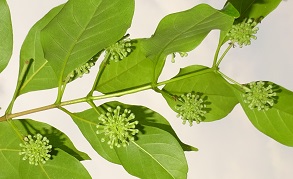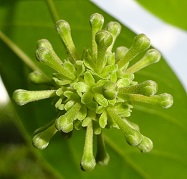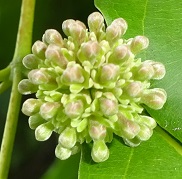| Home | Nature Weekly Index |
18 September 2016 | Gambir | Uncaria gambir |
Last Sunday, I was very excited to discover a large population of Gambir (Uncaria gambir) with hanging flower buds along the other side of a large drain that run along a stretch of main road. There was no way that I could take any good picture from the side of the drain that I was standing. The drain was relatively deep and wide. But the only way to get close to the plant was to get down to drain and walk across. Fortunately, there was only a small stream of water flowing through at that time and there was a set of metal-ring steps at one of the drain's vertical wall. With little hesitation, I climbed over the waist-high barrier and got into the drain. I did not want to miss this opportunity to snap these precious pictures at close range. This was the first time that I saw a complete set of Gambir flower bud. The only other time that I saw some remains of its flowers was in 2012 at Admiralty Park.




Gambir was once an important crop in the history of Singapore, specifically in the 1830s through 1850s. However, the process of getting to its end product was rather detrimental to the surrounding forest. The Gambir population currently found in the wild are likely to be descendants from that era. According to the 2009 Singaprore flora checklist, this climbing shrub is not a native plant.
Gambir extract has many uses. In traditional Chinese medicine, it is known as hook vine (钩藤 in Chinese) since the plant part with the hook is being used. In Korea, many over-the-counter medications for the treatment of dyspepsia, halitosis, vomiting, and anorexia contain extract from this plant. In Japan, it is used to treat diarrhoea, vomiting, and gastritis [1]. There was a patent on an anti-aging agent extracted from this climber filed by a Japanese inventor back in 2001. This agent seemed to inhibit substances in the skin that play a significant role in wrinkle formation. I have found at least one anti-wrinkle cosmetic cream that mentioned gambir-plant extract as one of the ingredients.
The combined extracts from the leaf of Uncaria gambir and the root bark of Morus alba in equal ratio had been shown to reduce pain and lower inflammation in an animal study that mimic osteoarthritis condition [1]. More recently, a novel α-glucosidase inhibitory constituent was isolated from Uncaria gambir [2]. Inhibitors of α-glucosidase are potential anti-diabetic medication.
While looking up for information on Gambir, I came across a mysterious herbal product known as Gambir Sarawak that claimed to assist with male sexual function and seemed to be rather well-known in Malaysia. It claimed to be made from the bark of Gambir tree. A very recent publication [3] from the Illicit Drug Division of Health Science Authority in Singapore appeared to show otherwise. Based on the analysis results in the laboratory, the main content is likely to be toad venom (known as 蟾酥 in traditional Chinese medicine). One of the compound in toad venom is bufotenine. This compound may cause hallucination and therefore is a controlled drug in many countries including Singapore. It is probably safe to conclude that the plant Uncaria gambir has nothing to do with Gambir Sarawak concoction. It is uncertain why Gambir got to associate with this illicit concoction.
References:
[1] Yimam M et.al. UP3005, a botmnical composition containing two standardized extracts of Uncaria gambir and Morus alba, improves pain sensitivity and cartilage degradations in monosodium iodoacetate-induced rat OA disease Model. Evidence-Based Complementary and Alternative Medicine 2015, Article ID 785638, 10 pages. | Read article |
[2] Kim TH. A novel α-glucosidase inhibitory constituent from Uncaria gambir. Journal of Natural Medicines 2016;70(4):811-815. | Read abstract |
[3] Lim WJ et al. Gambir, "Gambir Sarawak" and toad venom. Drug Testing and Analysis 2017;9(3):491-499. | Read article |